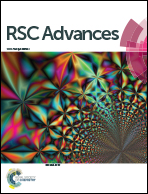Highly selective detection of nitrotoluene based on novel lanthanide-containing ionic liquids†
Abstract
Two novel fluorescent ionic liquids based on europium and dysprosium, [MOEMIm][Ln(NO3)4] (Ln = Eu, Dy), were synthesized. They exhibited good fluorescence properties under UV-light irradiation, and the phosphor presented bright red (Eu3+) and light blue (Dy3+) luminescence. This is the first time that the application of lanthanide-based room temperature ionic liquids has been investigated in the field of fluorescence analysis for aromatic compounds. As a fluorescence-quenching sensor for o-(m-, p-)nitrotoluene, trace amounts of the quenchers caused the fluorescence intensity to decrease and produced significant fluorescence quenching. Additionally, p-nitrotoluene gave the most significant fluorescence quenching effect among the three isomeric nitrotoluenes; also, the quenching coefficient KSV was calculated using the Stern–Volmer equation. What's more, the two fluorescent ionic liquids demonstrated high selectivity toward nitrotoluene even in the presence of methylbenzene, phenol, chlorobenzene, and aminobenzene. Hence, the selective recognition of nitrotoluene from other aromatic compounds may be used for the analytical detection of nitrotoluene.



 Please wait while we load your content...
Please wait while we load your content...